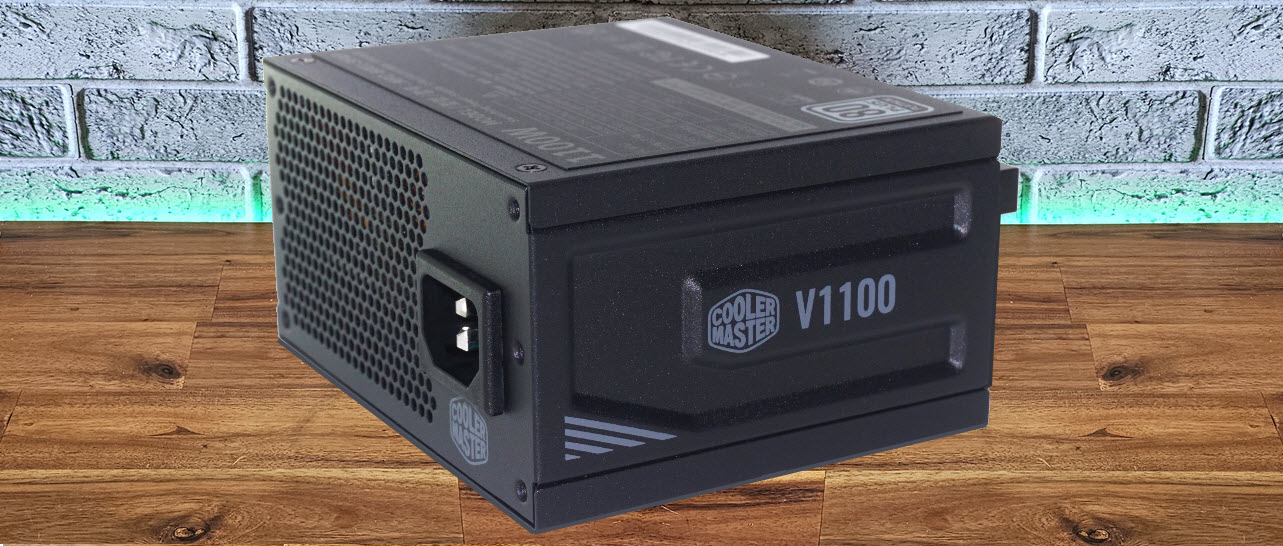Tom's Hardware Verdict
The Cooler Master V SFX Platinum 1100 is a remarkable achievement in power density, offering 1100W in a compact SFX form factor. While it excels in build quality and efficiency, thermal and noise performance under heavy loads hinder its appeal, while the electrical performance leaves a lot to be desired. Ideal for niche builds, it is less suited for mainstream use.
Pros
- +
Very high power-to-size ratio
- +
80 Plus Platinum efficiency
- +
Fully modular design
- +
ATX 3.0 compliant
Cons
- -
High noise under load
- -
Not ideal for hot environments
- -
Thermal stress at high temperatures
- -
Poor power quality
- -
No fanless operation mode
- -
Expensive
Why you can trust Tom's Hardware
Cooler Master is a well-known brand in the PC hardware industry, offering a wide range of products including computer cases, cooling systems, and power supplies. With over 30 years of experience, the company has established itself as a reliable and innovative provider of PC components. In recent years, Cooler Master has been expanding its portfolio to include smaller form factor power supplies, known as SFX units, to cater to the growing demand for compact and portable gaming PCs.
The company's V SFX Platinum 1100 is a powerful 1100-Watt power supply that also boasts an 80 Plus Platinum certification, ensuring high efficiency and lower energy consumption. Designed to compete with the best power supplies for high-end gaming and workstation systems, the Cooler Master V SFX Platinum 1100 is a fully modular unit that can support multiple high-performance graphics cards (such as the best GPUs), CPUs, and storage devices. Aside from its ludicrous power output for an SFX unit, the V SFX Platinum 1100 also brings ATX 3.0 compliance and has a 12VHPWR connector in SFX format. In this review, we will take a closer look at the $200 V SFX Platinum 1100 and evaluate its performance, design, and features.
Specifications and Design
| Row 0 - Cell 0 | Row 0 - Cell 1 | Row 0 - Cell 2 | Row 0 - Cell 3 | Row 0 - Cell 4 | Row 0 - Cell 5 |
| RAIL | +3.3V | +5V | +12V | +5Vsb | -12V |
| MAX OUTPUT | 20A | 20A | 91.6A | 3A | 0.3A |
| Row 3 - Cell 0 | 120W | Row 3 - Cell 2 | 1099.2W | 15W | 3.6W |
| TOTAL | 1100W | Row 4 - Cell 2 | Row 4 - Cell 3 | Row 4 - Cell 4 | Row 4 - Cell 5 |
| AC INPUT | 100 - 240 VAC, 50 - 60 Hz | Row 5 - Cell 2 | Row 5 - Cell 3 | Row 5 - Cell 4 | Row 5 - Cell 5 |
| PRICE | $200 | Row 6 - Cell 2 | Row 6 - Cell 3 | Row 6 - Cell 4 | Row 6 - Cell 5 |
In the Box: Cooler Master V SFX Platinum 1100
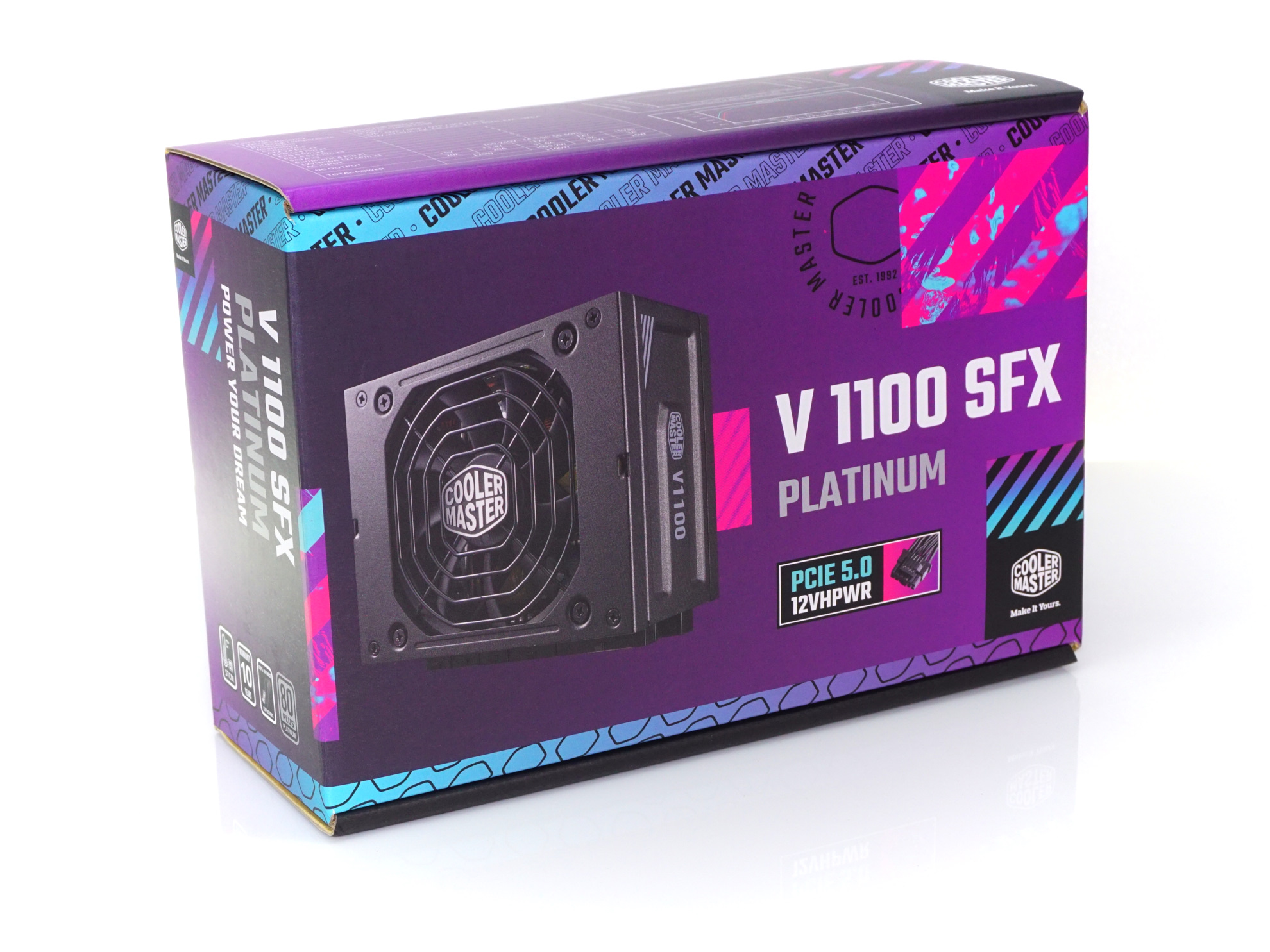
Cooler Master supplies the V SFX Platinum 1100 in a sturdy and colorful cardboard box. The combination of vibrant colors certainly has the box standing out on a shelf and enough information about the PSU and its capabilities can be found on the sides and rear of the box. Inside the box, sizable packaging foam pieces protect the unit itself. With its dimensions and weight in mind, this packaging could withstand the harshest of shipping conditions.
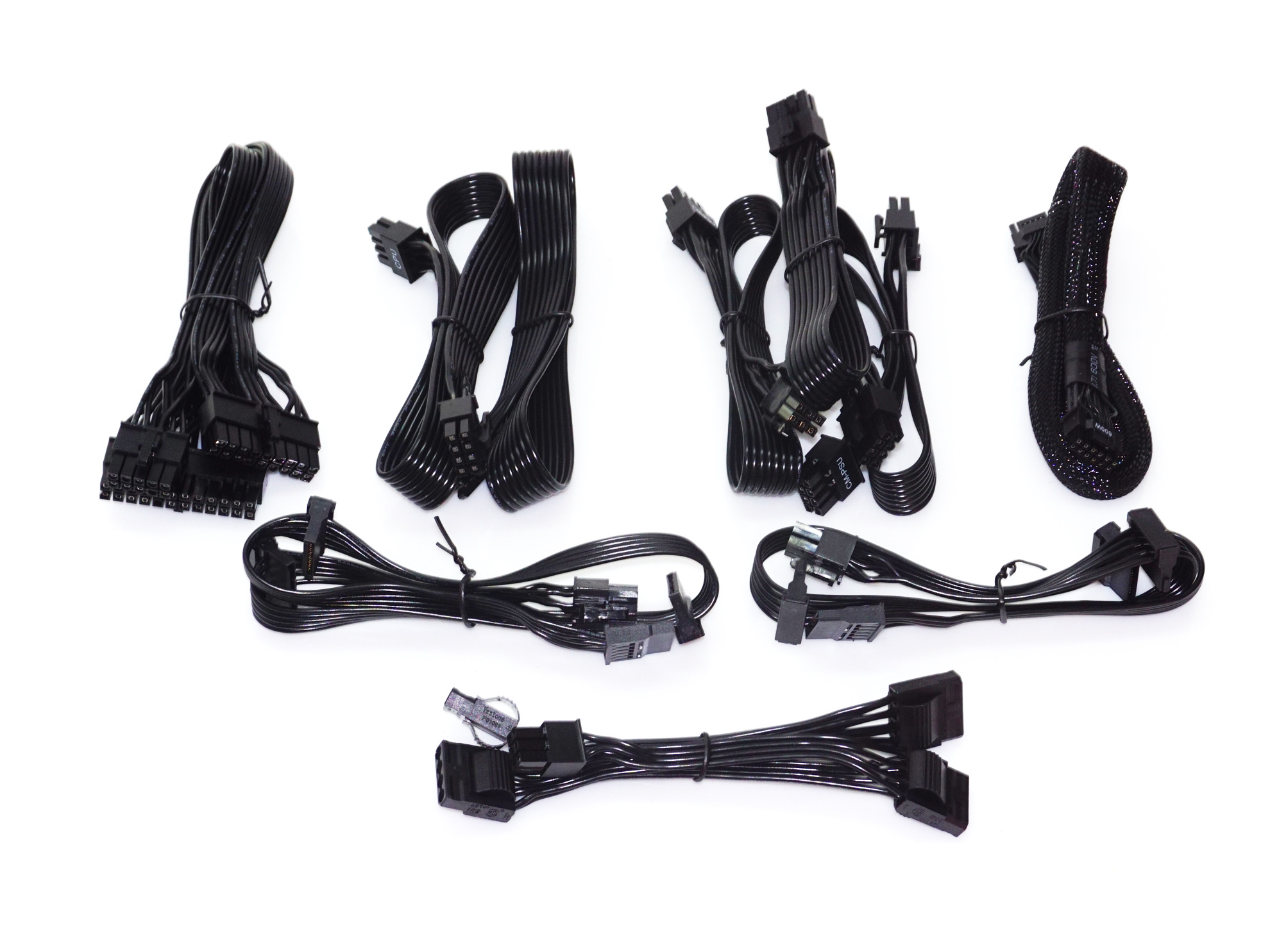
Inside the box, we found a relatively basic but functional bundle. The company supplies the typical AC power cable, an ATX-to-SFX adapter, eight screws (four for the PSU and four for the adapter, if necessary), a few cable ties, and two cable straps. Considering the short cables this PSU has, these should be enough. We also received a manual and a leaflet with instructions concerning the 12VHPWR cable. Both are very detailed for end-user documentation, down to the pinout diagrams of the connectors. We should note that Cooler Master suggests that the 12VHPWR connector should be used for up to 30 connection/disconnection cycles.

The Cooler Master V SFX Platinum 1100 is a fully-modular PSU and every cable can be detached, including the 24-pin ATX cable. All of the connectors and wires are black, with ribbon-like “flat” wires. The sole exception is the 12VHPWR cable, which is sleeved. The cables are shorter than those of an ATX PSU, which is a boon for those with smaller cases and compact systems where every millimeter counts, but it can be an issue if someone tries to install this unit inside a large ATX case using the adapter. Furthermore, the total number of connectors is rather small for a unit with that kind of power output.
| Connector type | Hardwired | Modular |
|---|---|---|
| ATX 24 Pin | - | 1 |
| EPS 4+4 Pin | - | 1 |
| EPS 8 Pin | - | 1 |
| PCI-E 5.0 | - | 1 |
| PCI-E 8 Pin | - | 3 |
| SATA | - | 8 |
| Molex | - | 4 |
| Floppy | - | 1 |
External Appearance of Cooler Master V SFX Platinum 1100
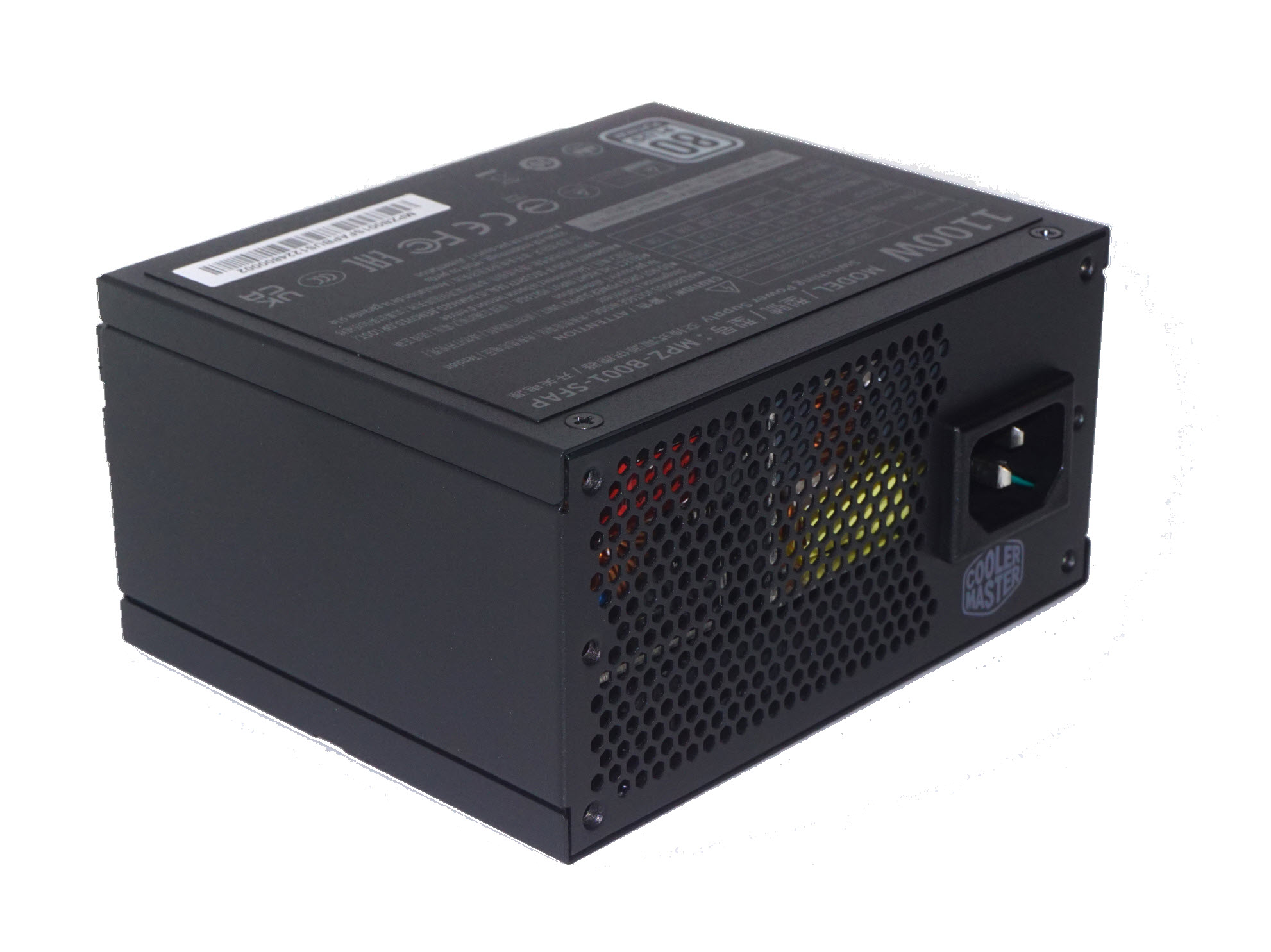
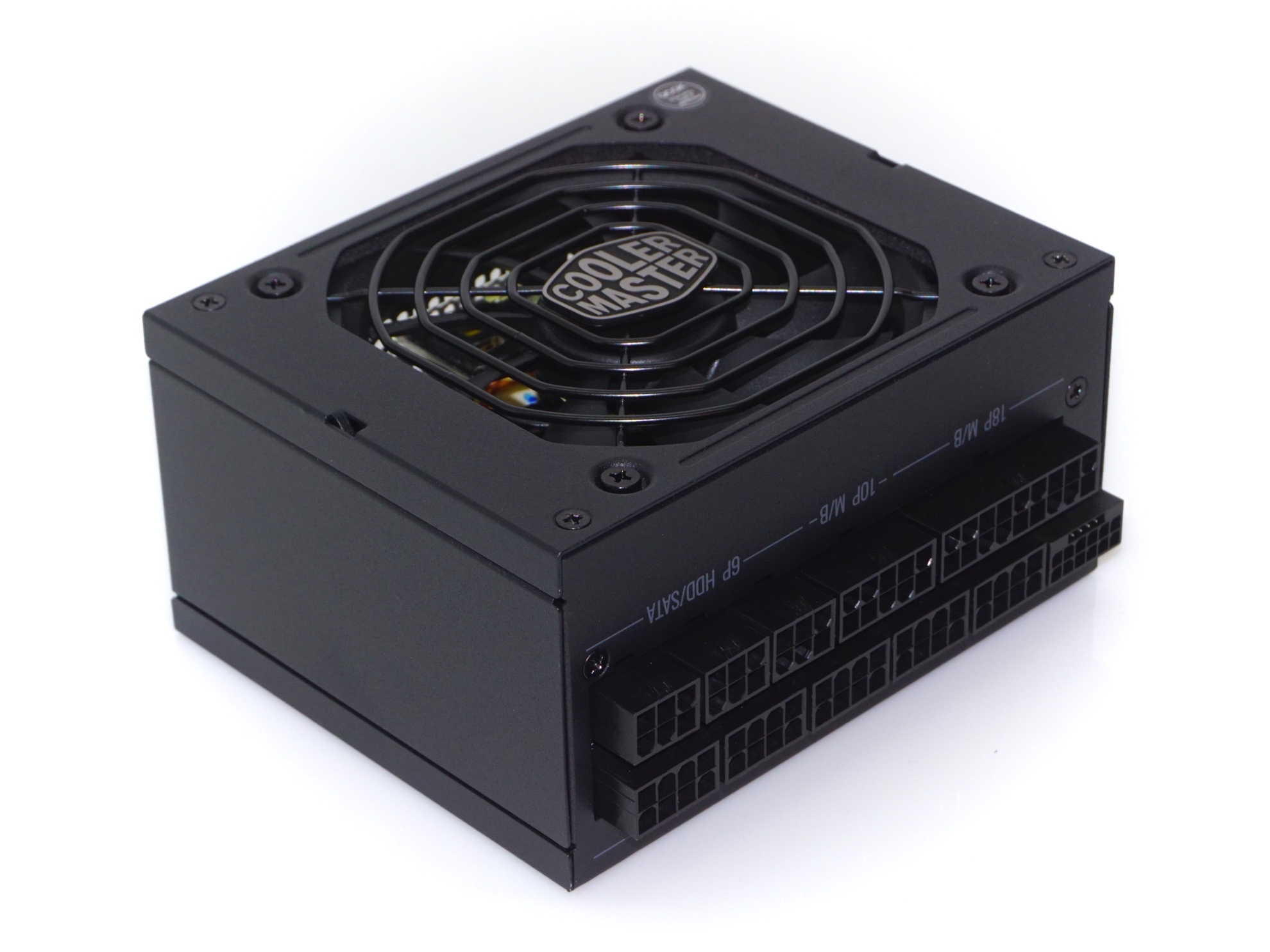
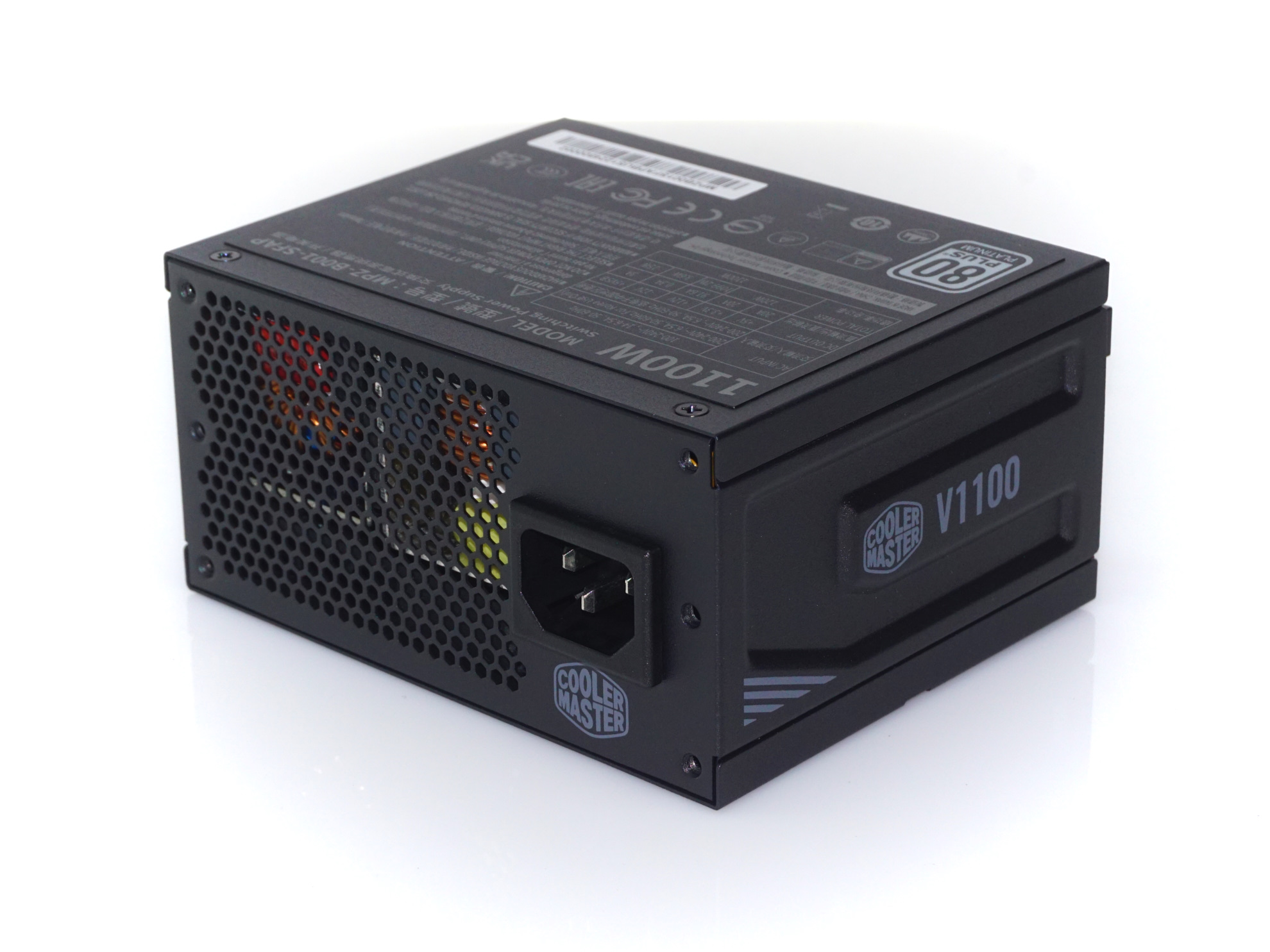
A mere glance at the Cooler Master V SFX Platinum 1100 reveals what an engineering feat this product truly is – the designing engineers managed to fit a platform capable of 1100 Watt continuous output and capable of excursions over 2000 Watts inside a standard 125 × 63.5 × 100 mm / 4.92 × 2.5 × 3.94 in (W×H×D) SFX form factor chassis. And let me reiterate that: that's the base SFX form factor, not the extended SFX-L form factor we typically see used for higher power units. The power-to-mass ratio of this unit is significantly greater than anything we've previously reviewed.
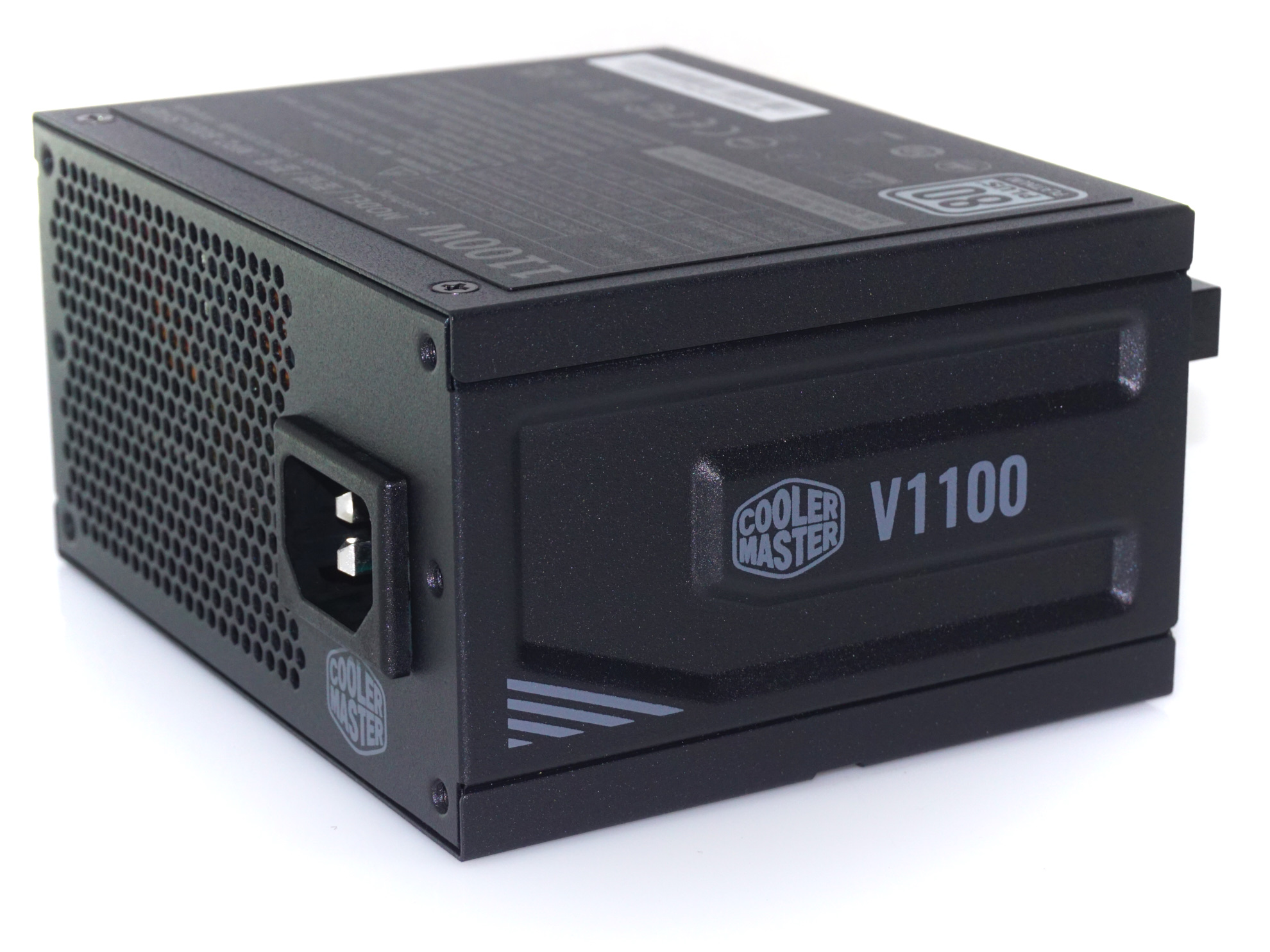

For the most part, the chassis of the V SFX Platinum 1100 is that of a standard SFX-sized unit that is sprayed with matte black paint. The company punched the left side of the unit with a geometric C-like shape, with the company and series logo printed in the middle. A large sticker with the unit’s certifications and specifications covers the top side of the chassis.
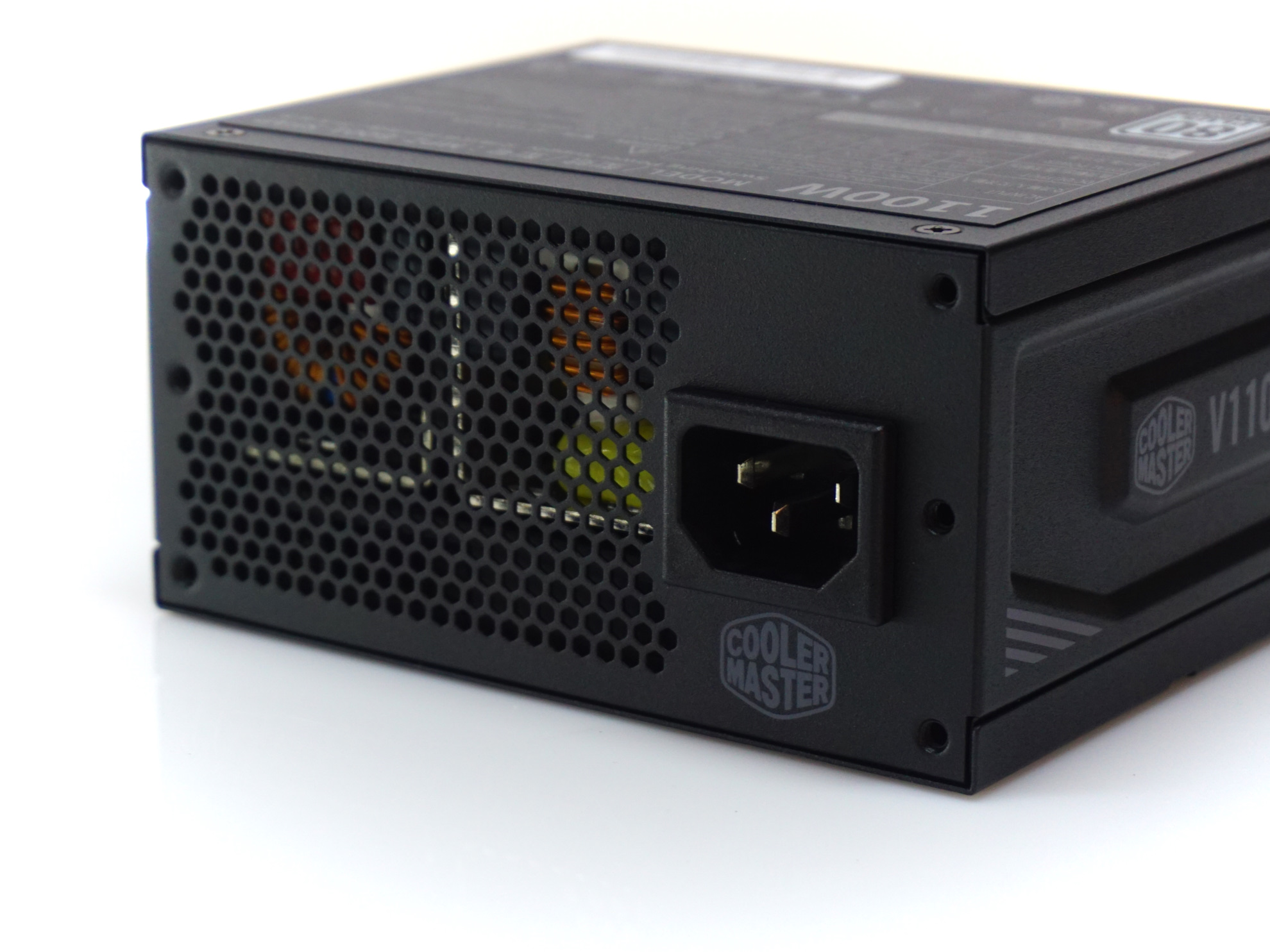
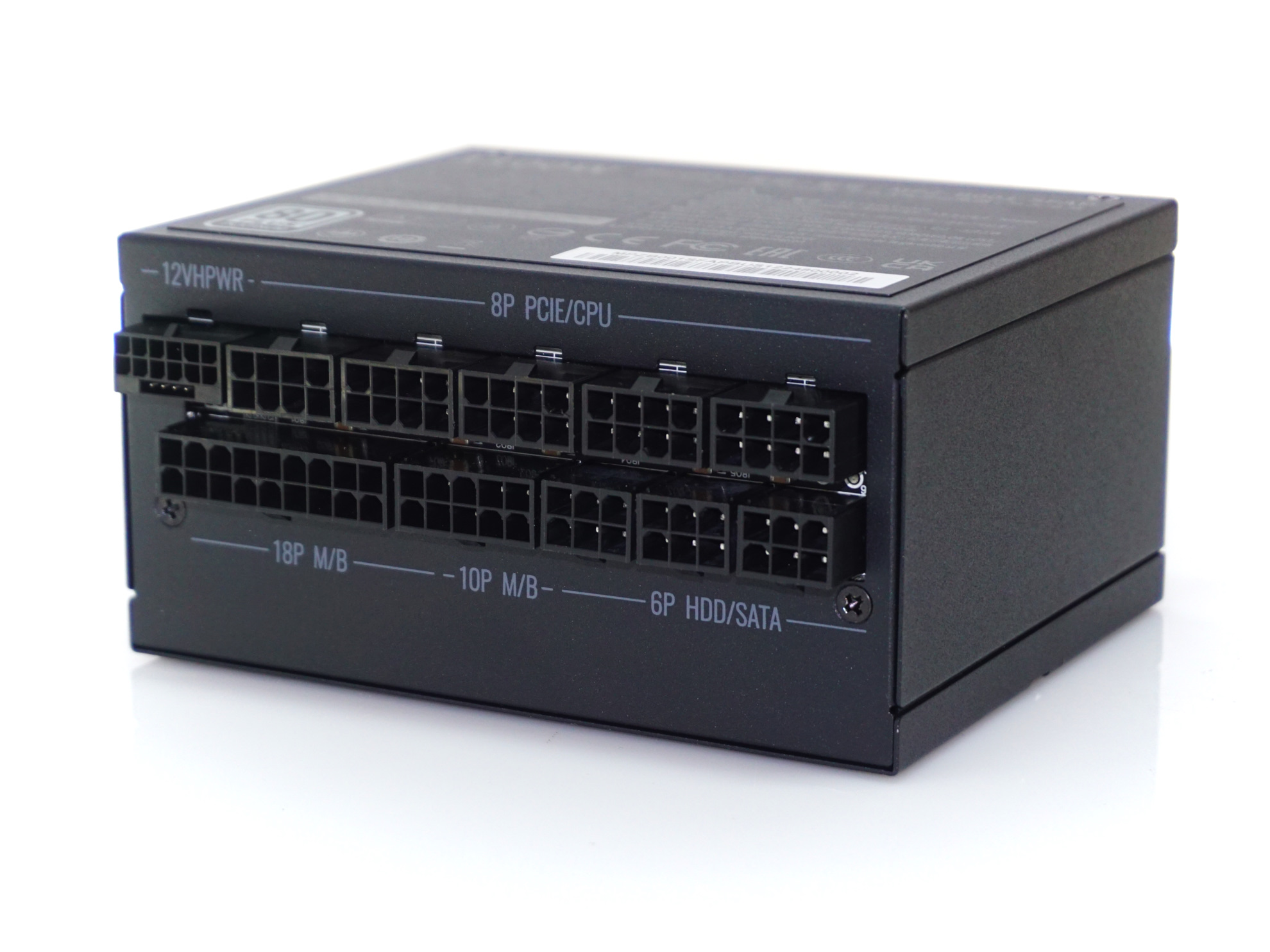
The rear side of the unit is fairly dull, home only to the necessary AC cable receptacle. There is no on/off switch as the designers of this unit needed every last bit of space they could get. The front side is densely populated with the connectors for the modular cables. The connectors are not color-coded but there is a basic legend printed on the chassis indicating what each connector is for. All of the connectors are keyed.
Internal Design of Cooler Master V SFX Platinum 1100
The 92 mm fan responsible for the cooling of the V SFX Platinum 1100 is made by Hong Hua (HA9215SH12FD-F00), an established manufacturer of quality products. It is a low-profile 15 mm thick fan with a very high current rating (0.46A) for its size. The maximum speed of 2800 RPM is high, but not unsurprisingly so for such a power-dense product and relative fan size. It has a fluid-dynamic bearing, which technically is a high-quality sleeve bearing. These last very long if not overstressed and will run significantly quieter compared to a typical ball bearing fans.
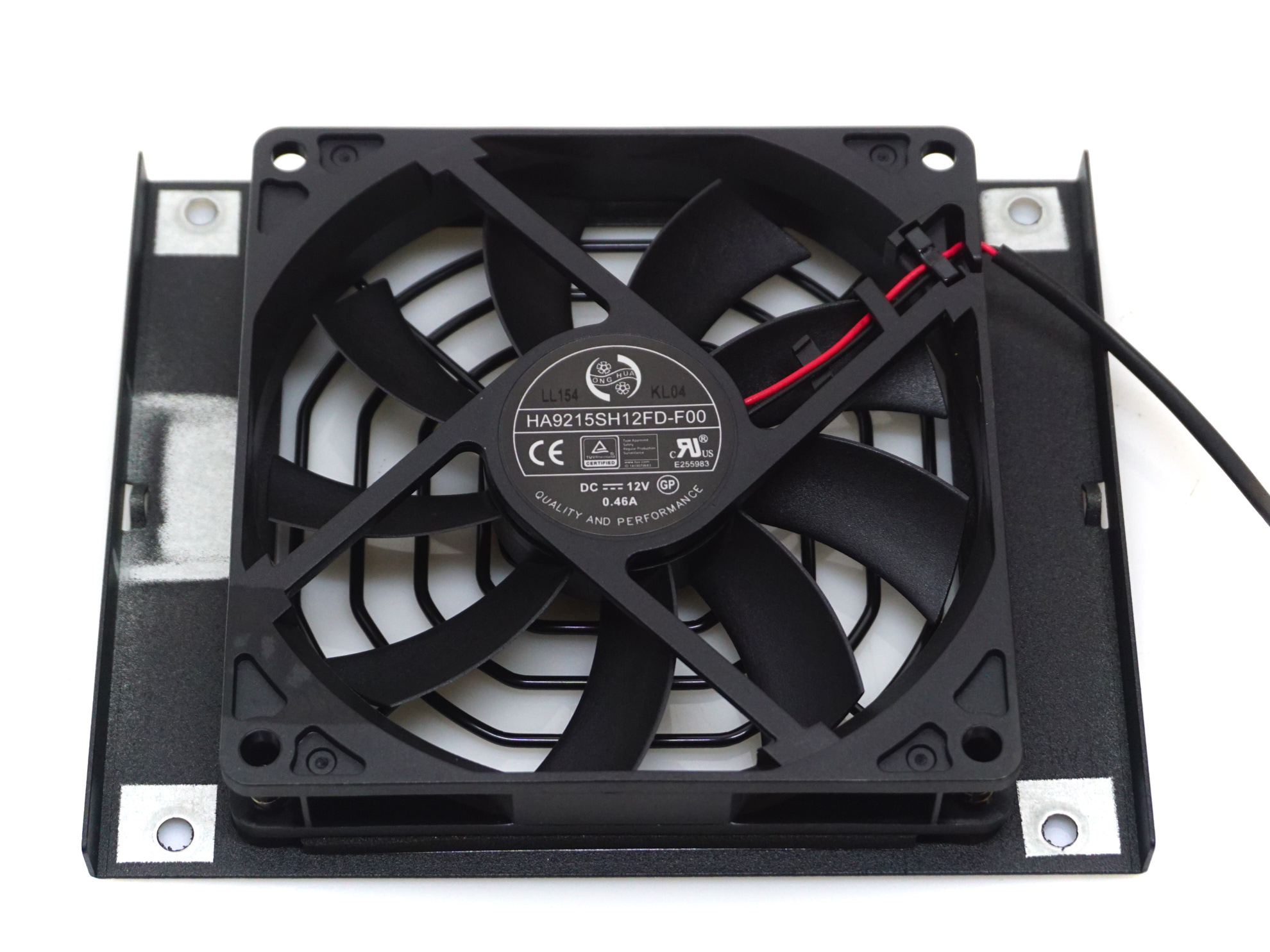
Although the design of the V SFX Platinum 1100 reminisces of CWT designs, the OEM behind its creation is a Taiwanese company named Sysgration. This is the first time we have encountered Sysgration as the OEM of a computer PSU, but Sysgration has been around for nearly 50 years, with a vast portfolio ranging from automotive electronics to battery systems. As a large percentage of the company is focused on energy systems, including on-grid and off-grid power products, their know-how of power electronics should not be underestimated.
The word “packed” does not suffice in describing the interior of the V SFX Platinum 1100. Whoever designed this unit is exceptionally good at making things fit (and we can only assume they spent their youth mastering Tetris). The filtering stage starts on the back of the AC receptacle, consisting of four Y capacitors, three X capacitors, and two filtering inductors – a royal filter for a design where every bit of space counts. There is only one bridge rectifier, on its own heatsink. The heatsink is simplistic but has sufficient surface area and openings for airflow.
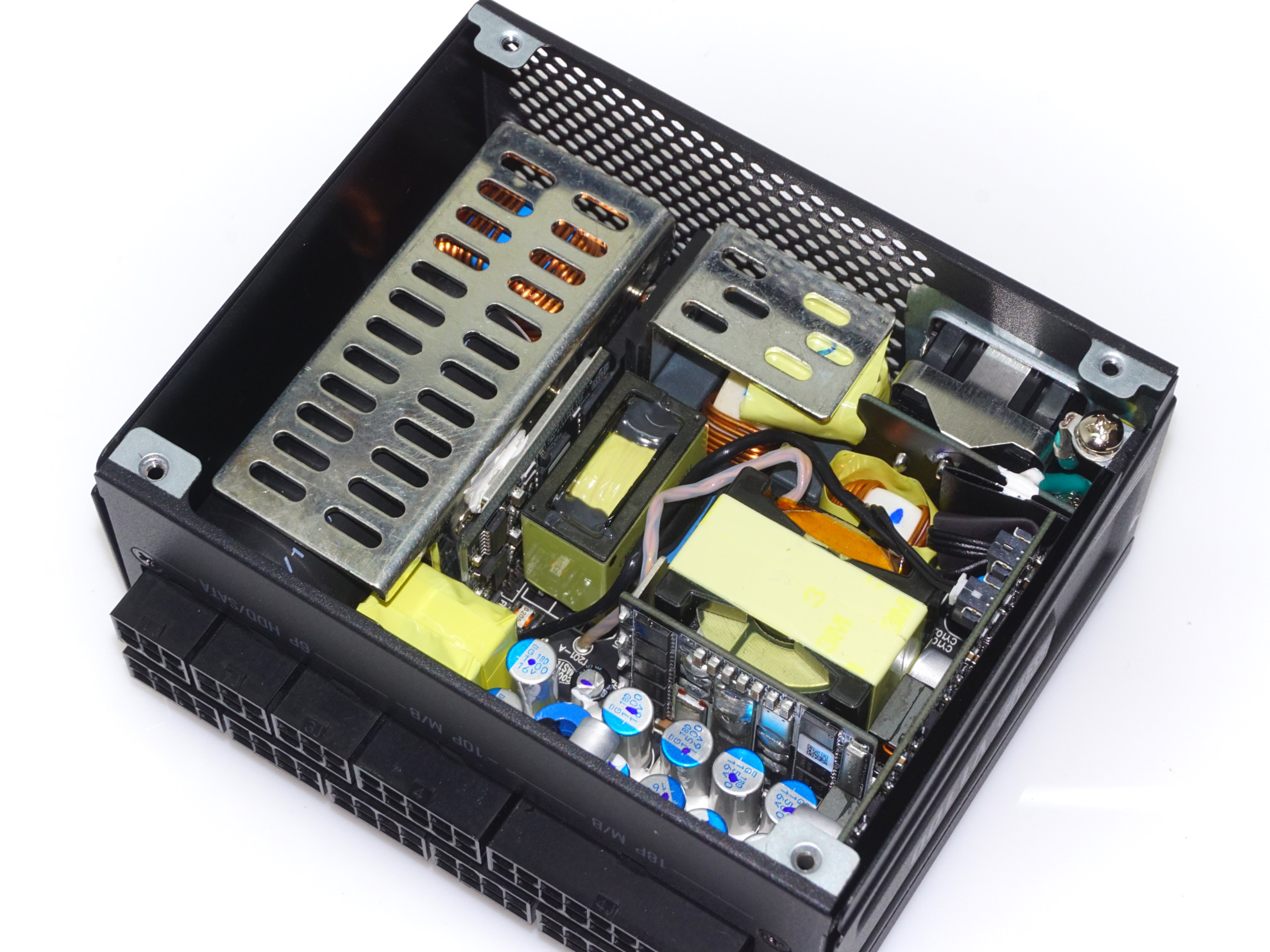
The APFC circuit is almost textbook, with the active components on the large heatsink across the edge of the PCB, one filtering coil and a single capacitor. One obvious difference here is that the huge 450V/800μF capacitor is placed sidewards, underneath the heatsink. The capacitor is made by EPCOS. On the primary side of the transformer, we find four primary side inversion MOSFETs that form the heart of an LLC resonant full-bridge design.
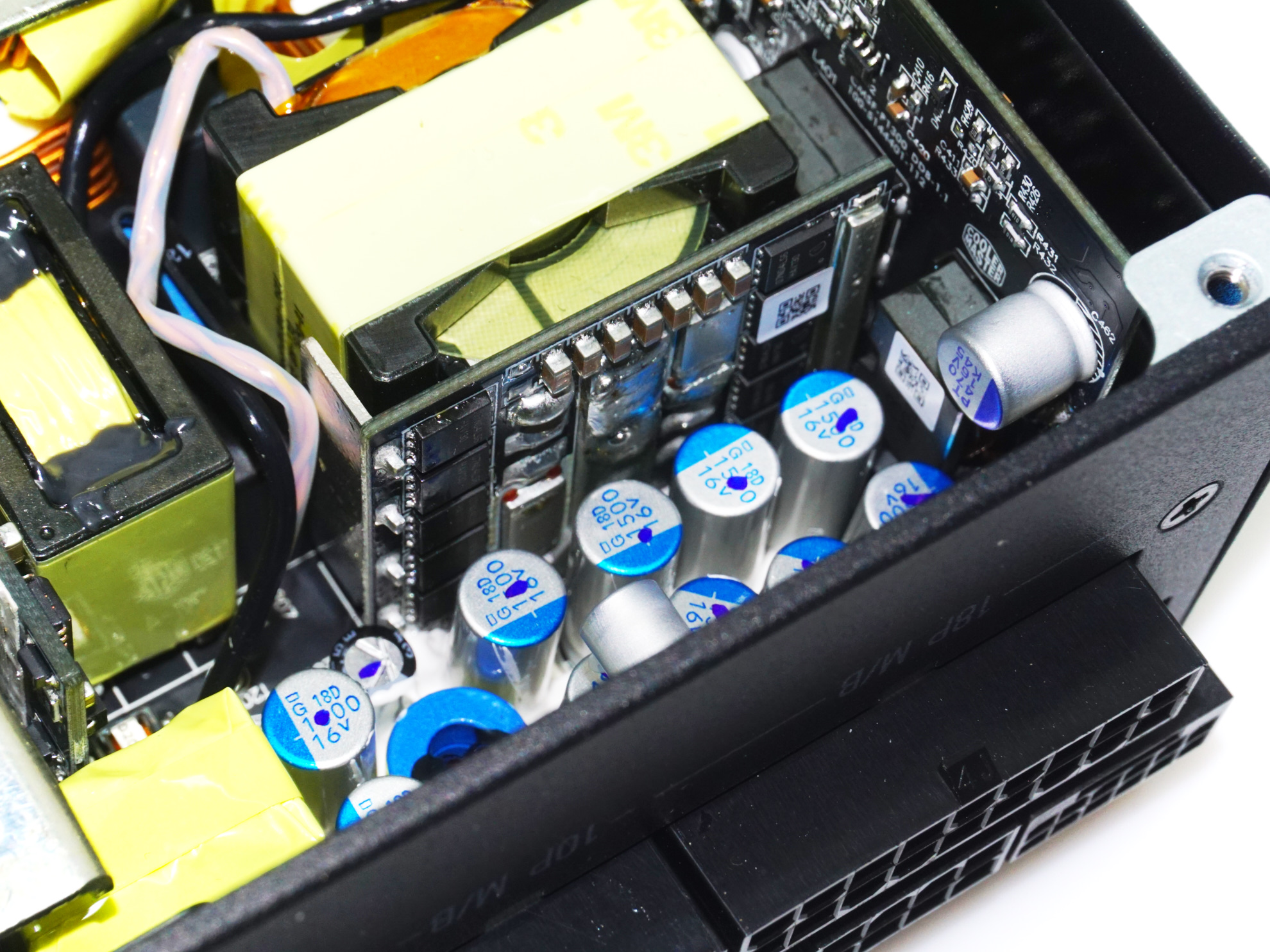
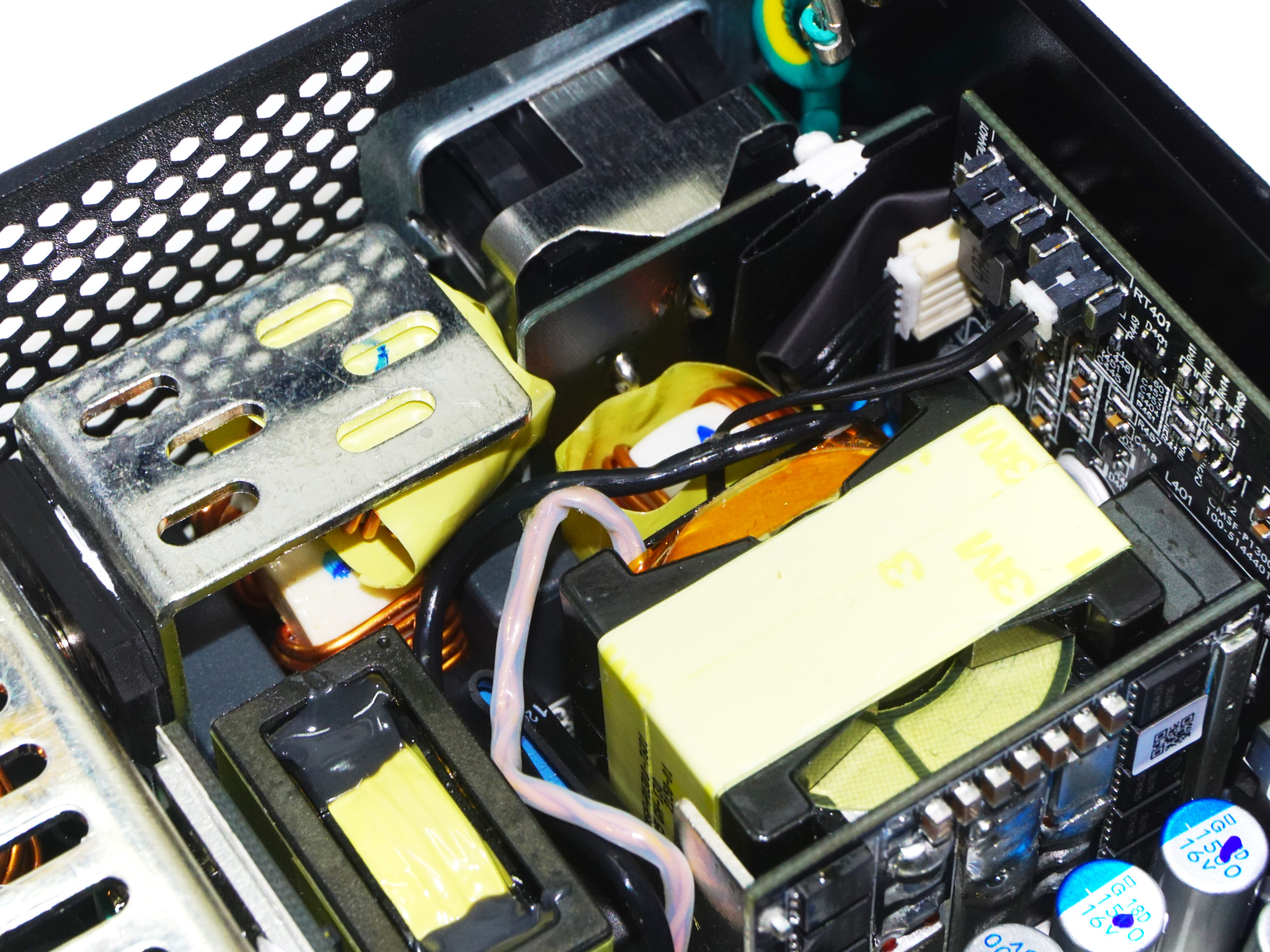
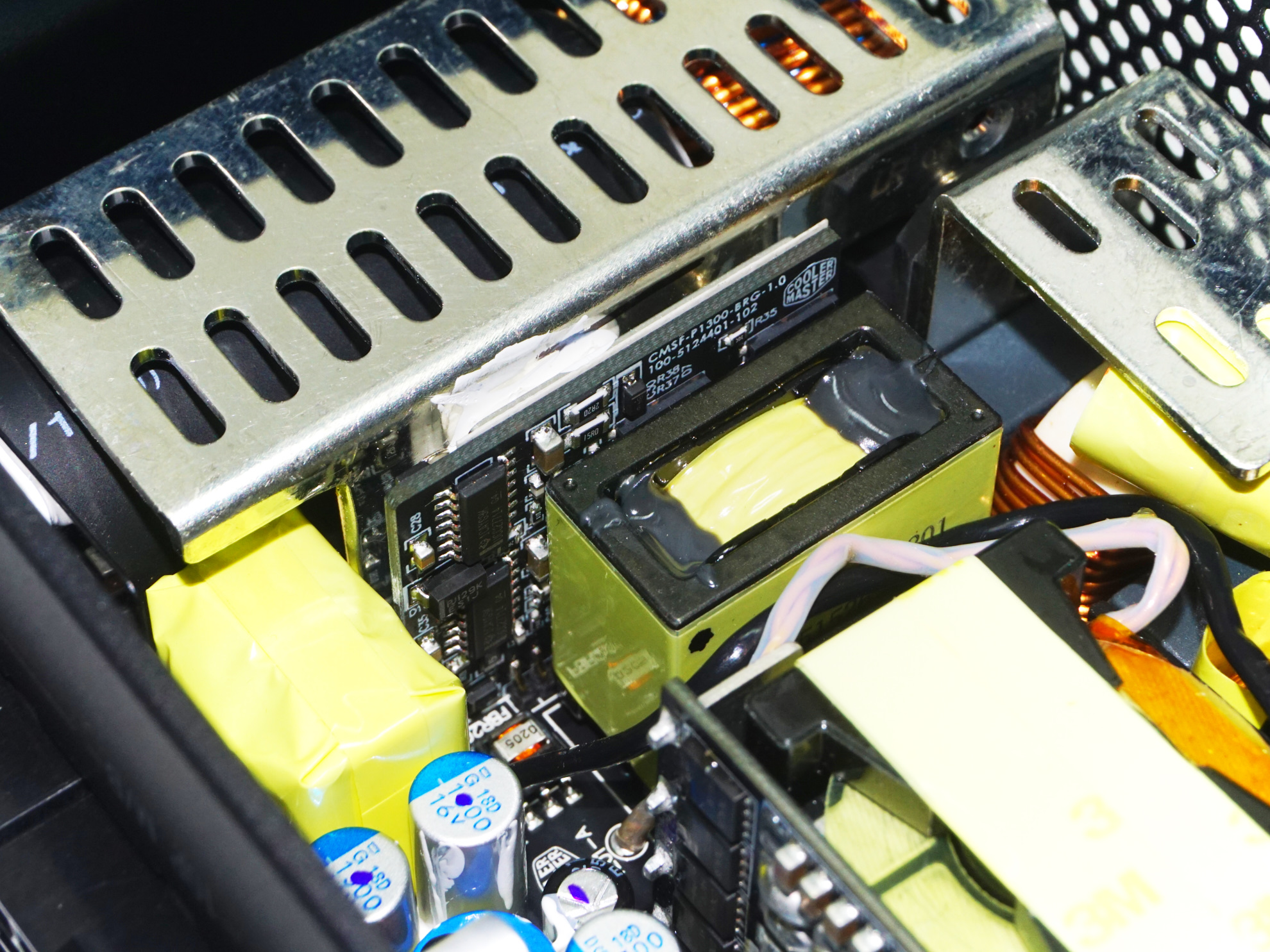
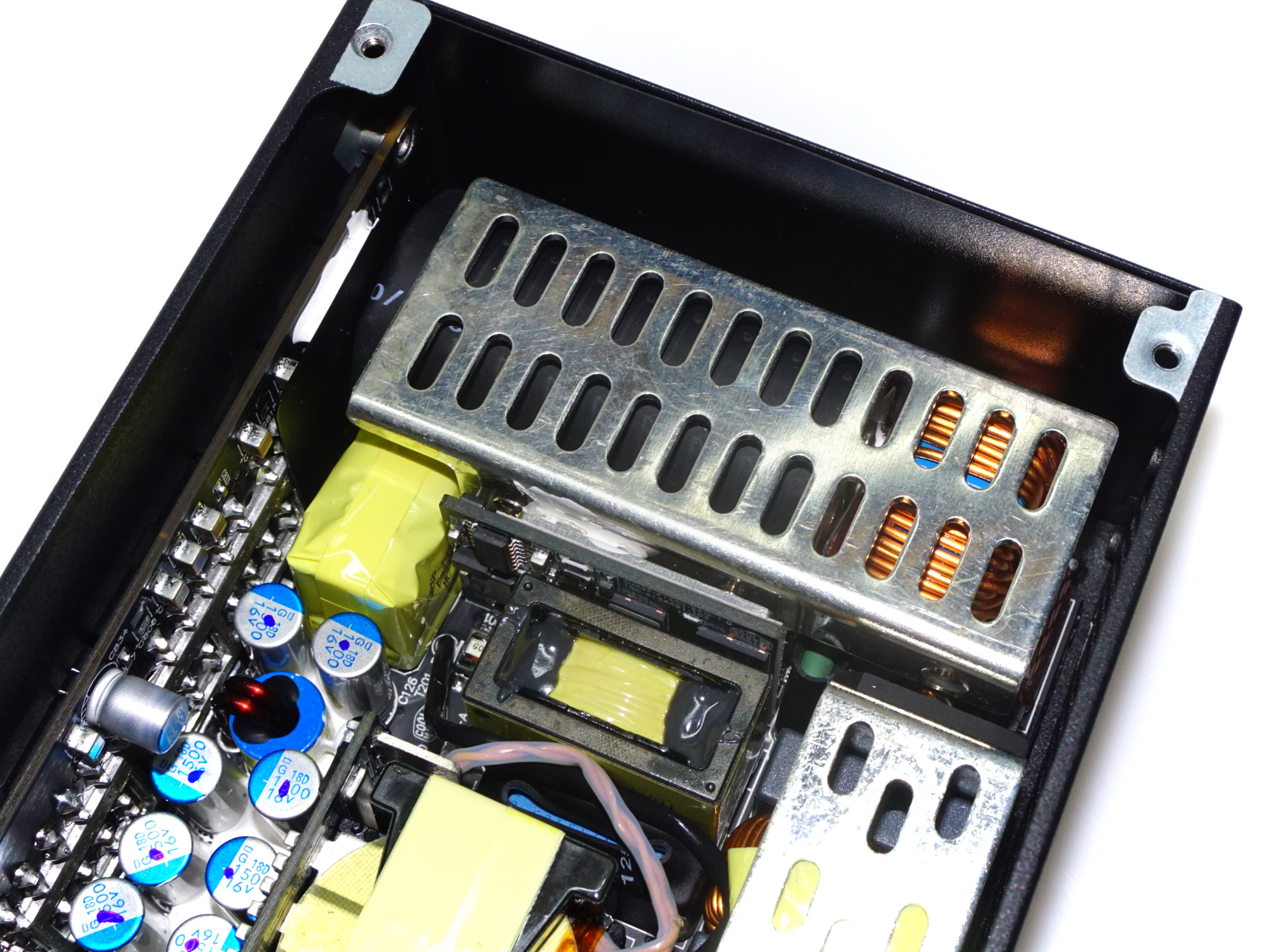
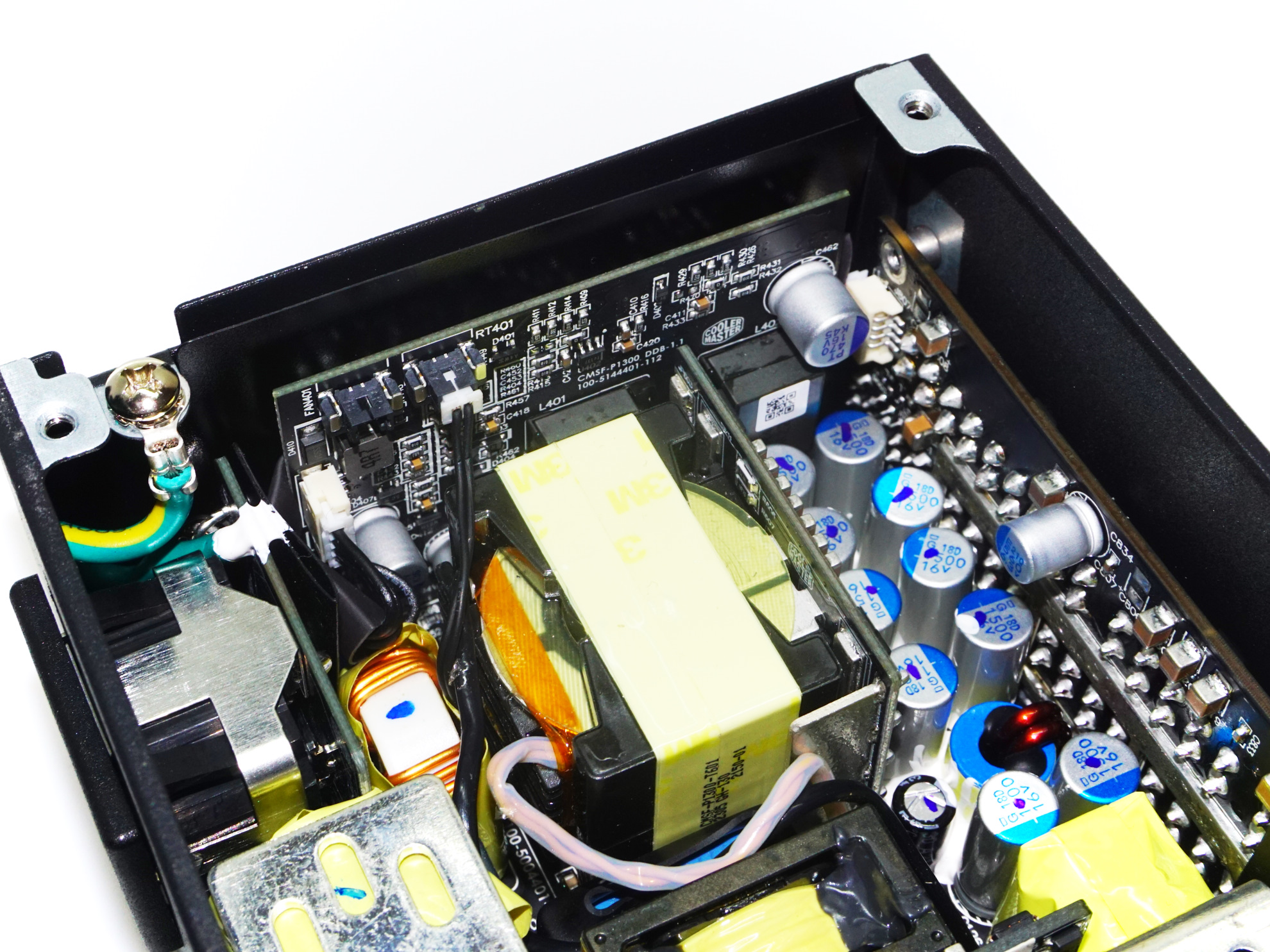
A vertical PCB on the secondary side of the transformer holds the ten MOSFETs that generate the main 12V line. We commonly find this practice on modern CWT designs, and now we see another manufacturer implementing it. This approach requires careful electrical and thermal design, as the secondary side MOSFETs essentially need to dissipate their thermal losses directly and/or via what tiny heatsinks can be attached to the vertical PCB. As with all modern PSU designs, the 3.3V and 5V lines are derived via DC-to-DC conversion circuits. All of the polymer capacitors are supplied by Nippon Chemi-Con and the few electrolytic capacitors are supplied by Rubycon.
Cold Test Results
Cold Test Results (22°C Ambient)
For the testing of PSUs, we are using high precision electronic loads with a maximum power draw of 2700 Watts, a Rigol DS5042M 40 MHz oscilloscope, an Extech 380803 power analyzer, two high precision UNI-T UT-325 digital thermometers, an Extech HD600 SPL meter, a self-designed hotbox and various other bits and parts.
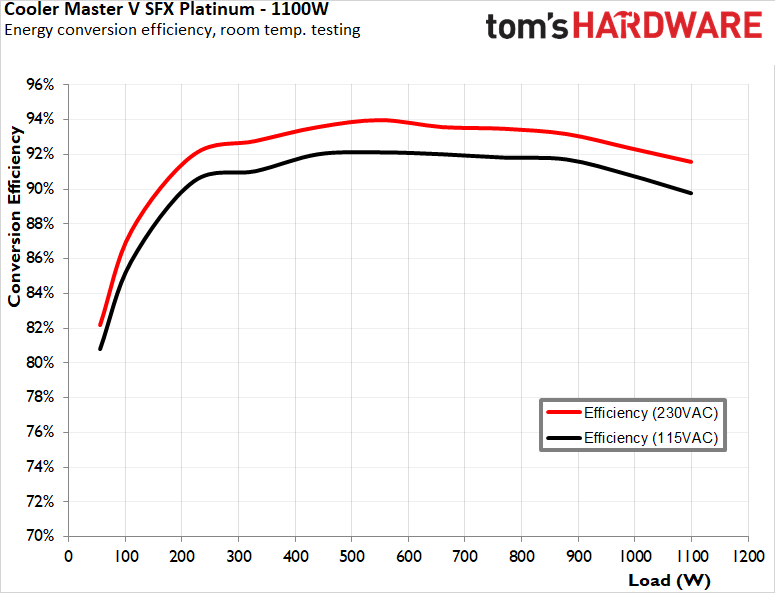
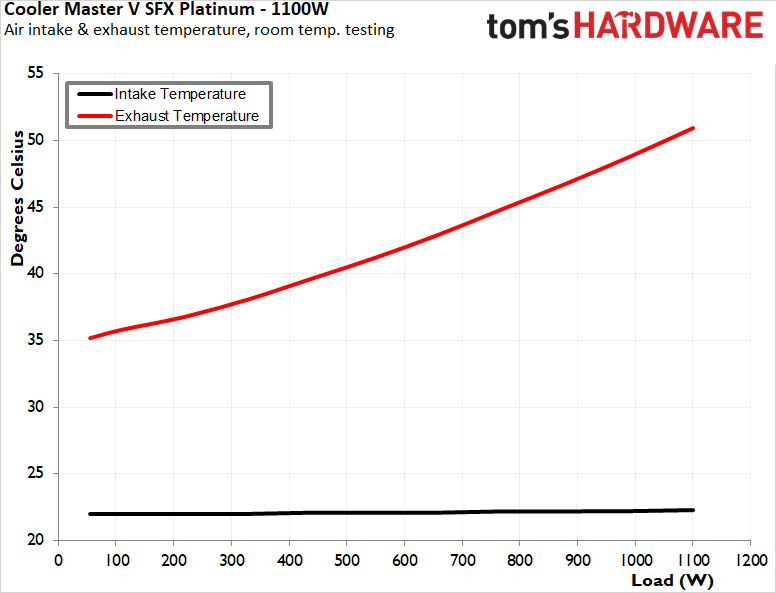
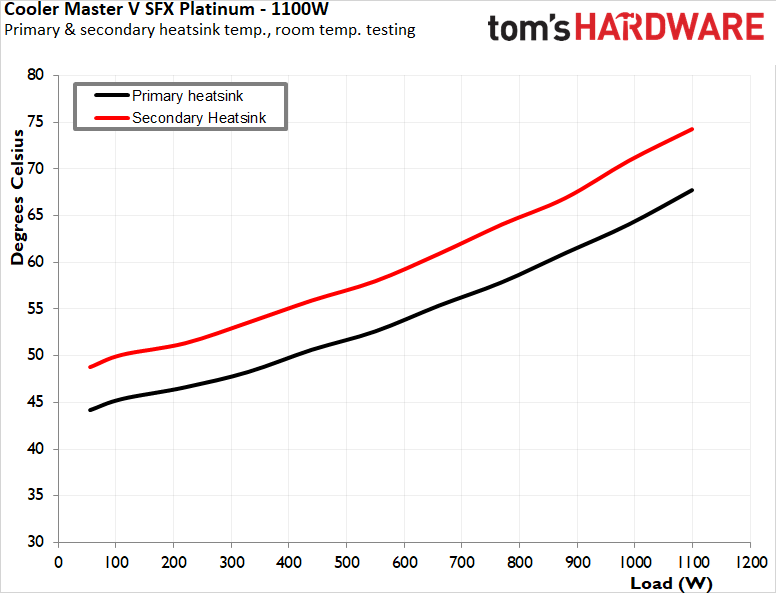
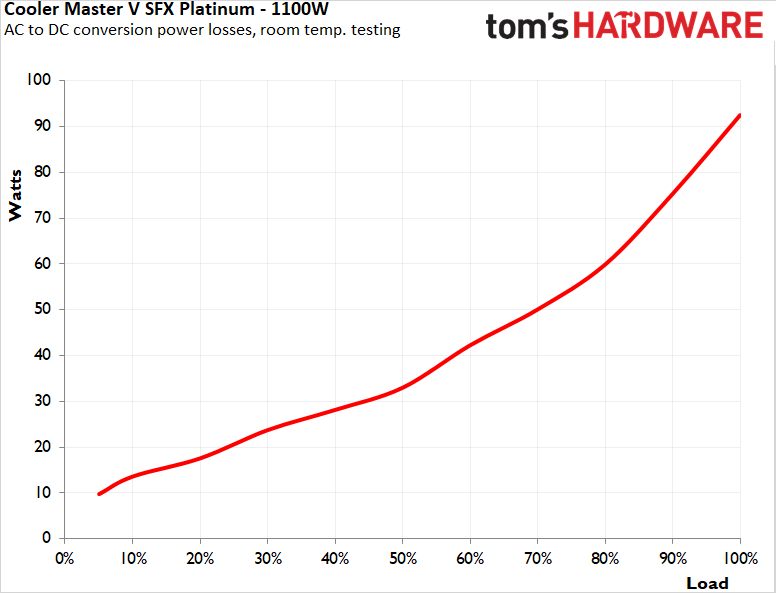
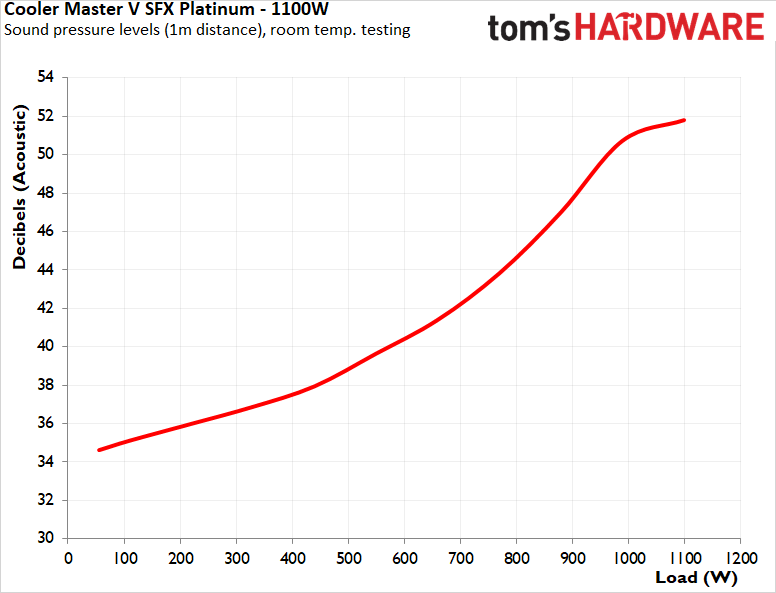
The efficiency of the Cooler Master V SFX Platinum 1100 is exceptional, with it being one of the very few units that meets the 80Plus certification regardless of the voltage input. It is significantly more efficient when powered via an 230V AC source, with an average efficiency of 93% across the nominal load range. That figure drops down to 91.3% when the unit is powered from a 115V AC source, but that still is very high and the PSU easily meets the 80Plus Platinum certification requirements.
Due to the very high efficiency, the thermal losses are low, thus we would normally expect to see very low internal temperatures. This is not the case here because the V SFX Platinum 1100 is very dense and its cooling capacity much lower than that of a comparable ATX unit, expectedly resulting in higher-than-regular internal temperatures. Nevertheless, these temperature figures are perfectly safe for the unit.
As expected from such a compact and power-dense unit, the designer did not risk having a fanless operation mode, which also led to fewer components for the thermal control circuit and saved a bit of precious space. The 92 mm fan will start immediately once the PSU is powered on but does stay relatively quiet while the load is low. It will speed up depending on the load, slowly at first but abruptly once the load is higher than 700 Watts. The PSU does get very loud when the load is very high, but not unexpectedly so – despite the high efficiency, its very compact dimensions and small cooling fan fashion a challenging cooling design.
Hot Test Results
Hot Test Results (~45°C Ambient)
Many performance indexes of the Cooler Master V SFX Platinum 1100 are greatly affected when the ambient temperature is very high, suggesting extreme thermal stress. The average efficiency degradation is greater than 2% across the nominal load range, one of the worst figures we ever recorded. Furthermore, the degradation of the unit’s efficiency near or at maximum capacity is extremely high, reaching a maximum of over 5.1%, suggesting extreme thermal stress.
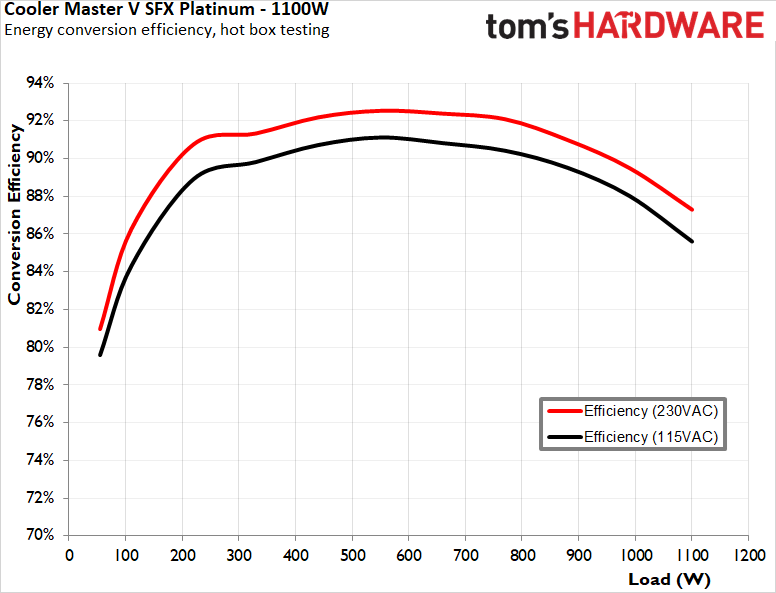
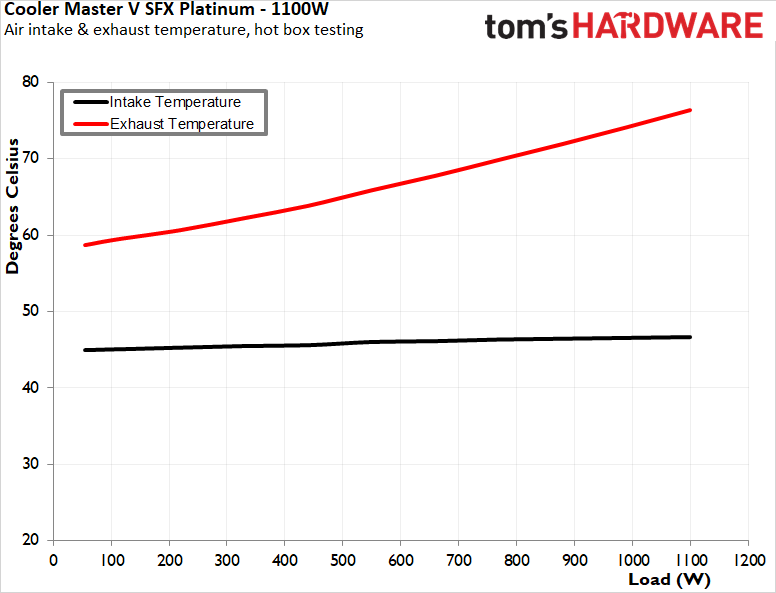
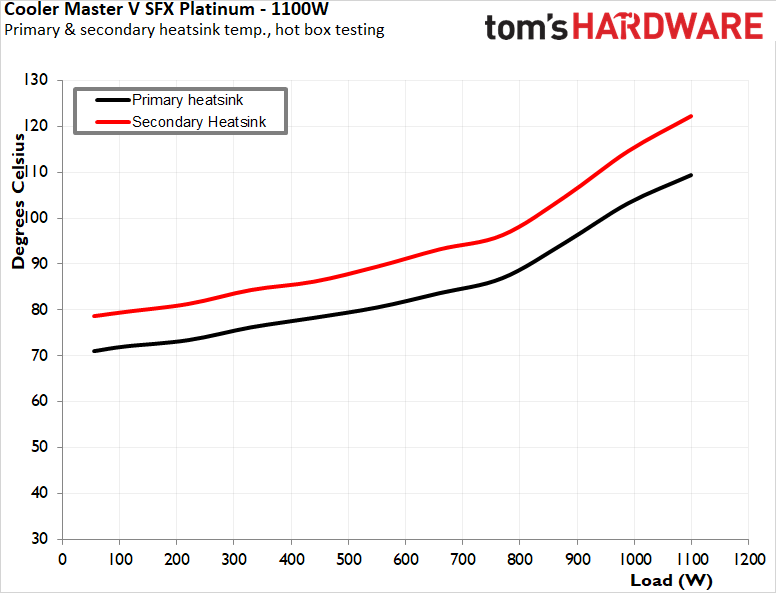
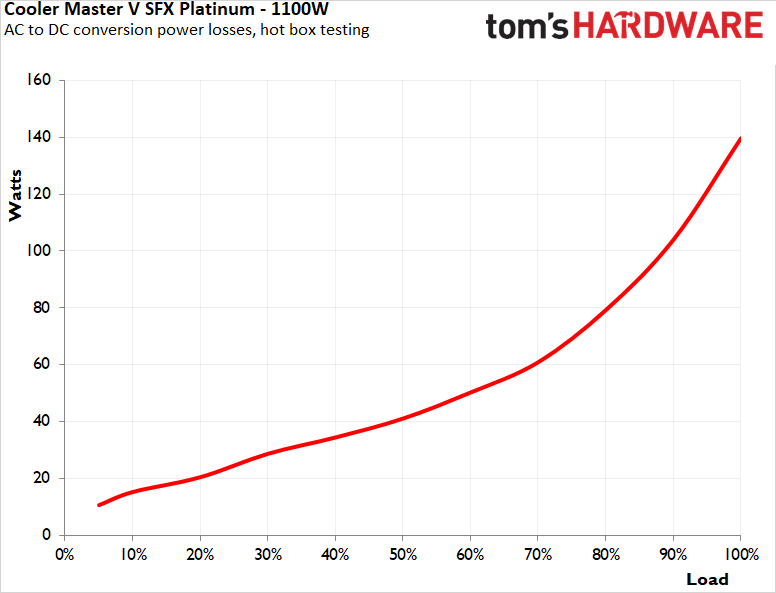
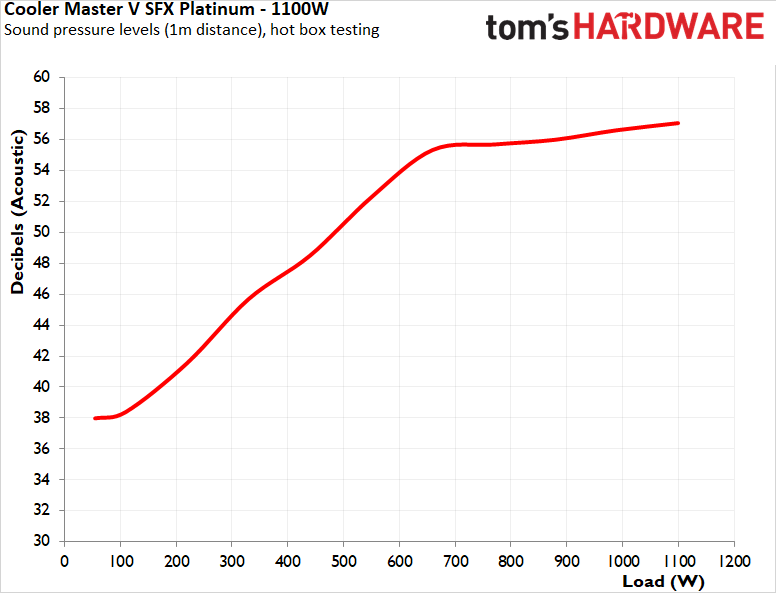
Regardless of the fan’s valiant efforts, the internal temperatures of the Cooler Master V SFX Platinum 1100 reach extremely high figures while the unit operates heavily loaded inside our hotbox. The PSU was either operating extremely close to the thermal shutdown limit, or it was just a matter of time until it was triggered, as we recorded surface temperatures of over 120°C. Such temperatures easily justify the thermal stress that the unit is exhibiting on electrical performance figures.
The 92 mm cooling fan starts at a relatively low speed but it now will be audible even if the load is just 100 Watts. Still, the noise figures are not high and the PSU would be tolerable for daily use. However, the fan quickly increases its speed as the load increases and even reaches its maximum speed when the V SFX Platinum 1100 is operating at just 60% capacity. After that, the fan is powerless to do anything else and is the reason why the internal temperatures of the unit climb so high. The designer of this unit clearly did not mean it to be used inside very hot environments and/or heavily loaded for prolonged periods of time, something also hinted at by the number of connectors it has.
PSU Quality and Bottom Line
Power Supply Quality of Cooler Master V SFX Platinum 1100
The electrical performance of the Cooler Master V SFX Platinum 1100 is fair while the load is low to middling but poor while the unit is heavily loaded. All of the voltage ripple figures do stay within the recommended design limits but it has been many years since we have seen a ripple greater than 100 mV on the 12V line, especially from a unit of this class and efficiency. On the other hand, voltage regulation is extremely tight on the 12V line and excellent on the minor 3.3V/5V lines. It is apparent that the tight dimensions prevented the designer from installing sufficient filtering.
| Row 0 - Cell 0 | Row 0 - Cell 1 | Row 0 - Cell 2 | Row 0 - Cell 3 | Row 0 - Cell 4 | Row 0 - Cell 5 | Row 0 - Cell 6 | Row 0 - Cell 7 | Row 0 - Cell 8 |
| Load (Watts) | 221.49 W | Row 1 - Cell 2 | 552.2 W | Row 1 - Cell 4 | 825.89 W | Row 1 - Cell 6 | 1099.19 W | Row 1 - Cell 8 |
| Load (Percent) | 20.14 | Row 2 - Cell 2 | 50.2 | Row 2 - Cell 4 | 75.08 | Row 2 - Cell 6 | 99.93 | Row 2 - Cell 8 |
| Row 3 - Cell 0 | Amperes | Volts | Amperes | Volts | Amperes | Volts | Amperes | Volts |
| 3.3 V | 1.86 | 3.36 | 4.65 | 3.35 | 6.98 | 3.32 | 9.3 | 3.31 |
| 5 V | 1.86 | 5.08 | 4.65 | 5.05 | 6.98 | 5.02 | 9.3 | 5 |
| 12 V | 17.05 | 12.07 | 42.62 | 12.04 | 63.92 | 12.01 | 85.23 | 11.99 |
| Line | Regulation (20% to 100% load) | Voltage Ripple (mV) | Header Cell - Column 3 | Header Cell - Column 4 | Header Cell - Column 5 | Header Cell - Column 6 | Header Cell - Column 7 |
|---|---|---|---|---|---|---|---|
| Row 0 - Cell 0 | Row 0 - Cell 1 | 20% Load | 50% Load | 75% Load | 100% Load | CL1 12V | CL2 3.3V + 5V |
| 3.3 V | 1.4 | 12 | 14 | 18 | 22 | 18 | 34 |
| 5 V | 1.6 | 16 | 20 | 22 | 28 | 20 | 36 |
| 12 V | 0.7 | 24 | 40 | 62 | 104 | 110 | 68 |
As part of our standard testing, we test the primary protections of all PSUs we review (Over Current, Over Voltage, Over Power, and Short Circuit). The Cooler Master V SFX Platinum 1100 passed all of our tests successfully. It is also worthwhile to note that the OCP protection and OPP protection of this PSU were relatively low compared to other ATX 3.0 units, at 110% and 115% respectively. Other manufacturers have these protections set very high in order to achieve ATX 3.0 compliance but it would seem that this newly developed platform achieves compliance and reasonable protection figures at the same time.
Bottom Line
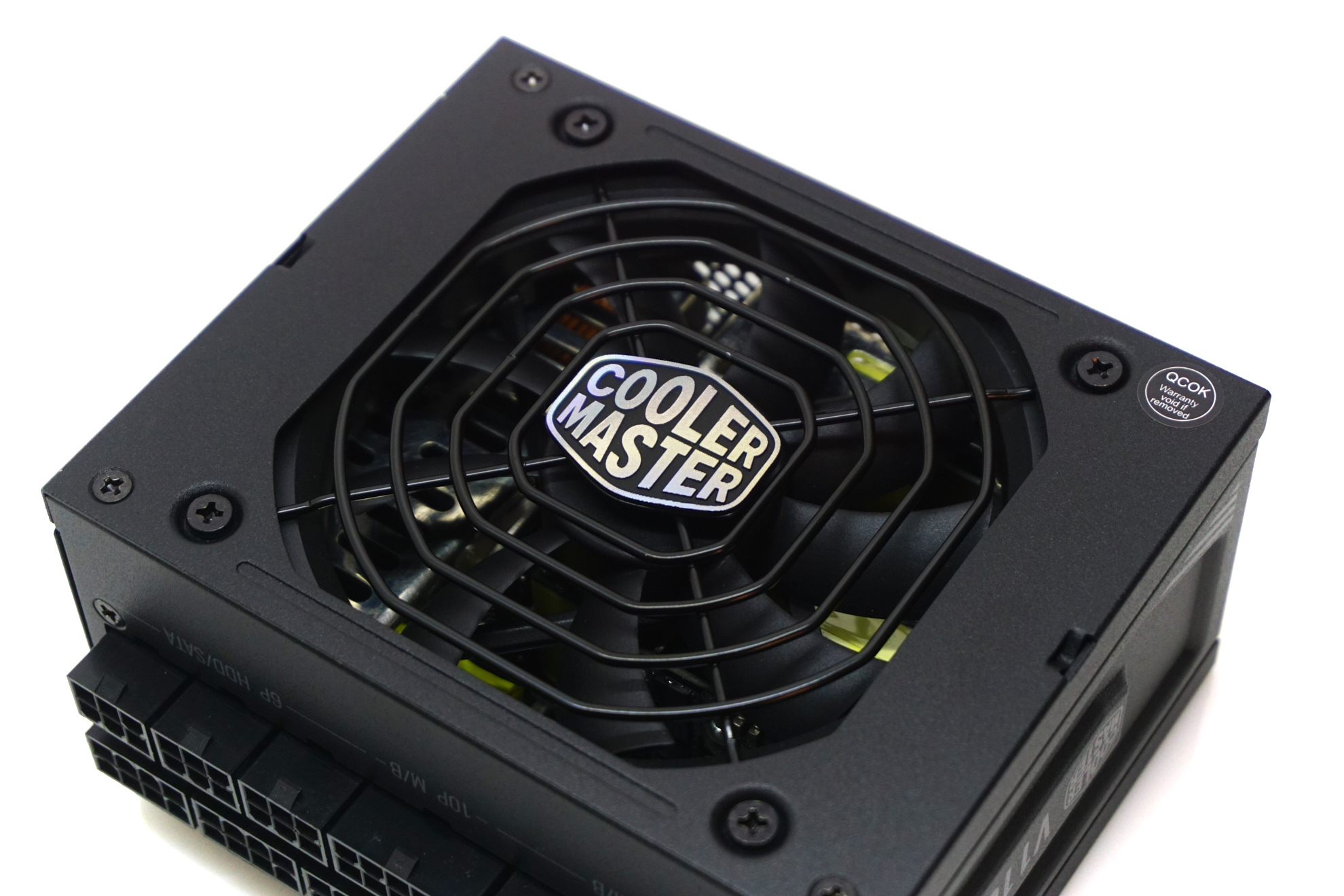
With such extreme power density and ATX 3.0 compliance in SFX proportions, the Cooler Master V SFX Platinum 1100 PSU certainly is a very unique product - albeit one that is a mixed bag when it comes to performance. It does have excellent build quality and components, most likely thanks to its OEM, Sysgration, which has years of experience in power electronics design. However, the cramped design of the unit hampers its overall performance, particularly at higher loads, where insufficient filtering and thermal stress result in poor power quality.
Voltage regulation is excellent at all times and the protections of the unit function perfectly, but filtering leaves much to be desired, with figures that barely stay within the recommended design limit. It is evident that the designers of this platform just ran out of space for additional filtering and the high temperatures made matters even worse for the unit. Considering that no figure went above the limit, the Cooler Master V SFX Platinum 1100 does pass in terms of acceptable power quality, but enthusiasts have come to expect more from a premium product.

The PSU performs well enough in room-temperature environments, but struggles to maintain fair operating temperatures when the ambient temperature is high. This is a significant issue, as extreme thermal stress leads to performance degradation, making it difficult to recommend for use in high-temperature environments. Noise levels are acceptable at room temperature, but high ambient temperatures result in very high noise levels, which may not be suitable for noise-sensitive environments.
Overall, the Cooler Master V SFX Platinum 1100 PSU is a unique product that caters to specific needs. With a current street price of $200, it is not unreasonably expensive for such a power-dense SFX unit but it remains a significant investment. Its excellent build quality, unique SFX form factor, and high-power output make it a compelling option for compact PC gaming and deep learning systems. However, the substantial prerequisites to avoid thermal and noise issues and high price point make it difficult to recommend as a mainstream product. It may be suitable for users looking to build a high-performance, compact PC and willing to pay the significant premium, but Cooler Master will have a hard time convincing the vast majority of the market.
MORE: Best Power Supplies
MORE: How We Test Power Supplies
MORE: All Power Supply Content

Dr. E. Fylladitakis has been passionate about PCs since the 8088 era, beginning his PC gaming journey with classics like Metal Mutant and Battle Chess. Not long after, he built his first PC, a 486, and has been an enthusiast ever since. In the early 2000’s, he delved deeply into overclocking Duron and Pentium 4 processors, liquid cooling, and phase-change cooling technologies. While he has an extensive and broad engineering education, Dr. Fylladitakis specializes in electrical and energy engineering, with numerous articles published in scientific journals, some contributing to novel cooling technologies and power electronics. He has been a hardware reviewer at AnandTech for nearly a decade. Outside of his professional pursuits, he enjoys immersing himself in a good philosophy book and unwinding through PC games.
-
Mindstab Thrull And somehow they managed to *not* name it something like the Cooler Master Power Master or Master Watts... Jay (of JayzTwoCents) might be impressed by that part alone!Reply
